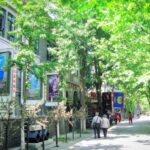Nanjing 1912 Street holds a special significance for Nanjing. Its architecture is a blend of ancient and modern, with quaint and exquisite buildings that are meticulously arranged, leaving an unforgettable impression on every visitor. Once the dormitory area for staff, young officers, and bank employees, these old buildings have now been transformed into restaurants and bars. There are also newly constructed buildings that mimic the old style, giving a feeling akin to Shanghai’s Xintiandi and Beijing’s Sanlitun, attracting urban, fashionable youth and many foreigners for a vibrant nightlife.
For those who appreciate diverse cuisines, there are dining establishments offering flavors from around the world. Min Du Hui’s private dishes, such as President Fish, Mei Ling Beef, and Shao Shuai Braised Pork; Fang Man Ting’s Shanghai-style dishes; Jiu Bai Guo’s hot pot; Qing Shan Yuan’s Korean cuisine; and Hara Taisho’s Japanese sushi and salmon, allow you to savor international tastes. Of course, there are also the essential bourgeoisie beverages such as Starbucks and the cold treats from Dairy Queen. For those who enjoy drinking, you can visit Zuo Ba for Japanese sake or Jason’s Foreign Trade Firm for wine. If you find drinking alone monotonous, you can head to Su He Bar to enjoy live music, or ENZO, a music bar. The Old Times Bar is frequented by middle-aged people seeking nostalgia, where singers perform old classics. Nanjing 1912 Street is open all year round, accessible 24/7. Key Tips: 1. Near 1912 Street, you will find attractions such as the Presidential Palace, Jiangning Weaving Museum, and Nanjing Library. One kilometer to the west of the block is Xinjiekou, Nanjing’s bustling commercial area, perfect for shopping. 2. For photography, consider taking pictures at dusk when the yellow light shines on the unadorned and unpretentious blue bricks, as if the vicissitudes of the past are revisited. 3. Don’t focus solely on capturing large scenes; sometimes the details are what truly stand out. Also, try looking out from indoors, as it might offer a different perspective.Nanjing 1912 Street
Nanjing 1912 Street holds a special significance for Nanjing. Its architecture is a blend of ancient[...]









